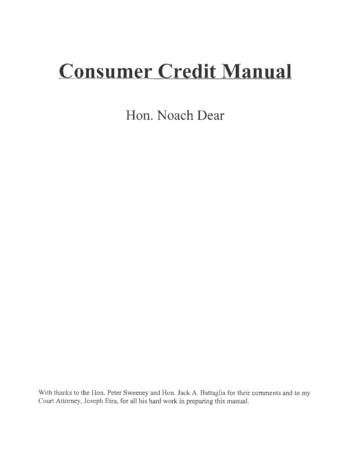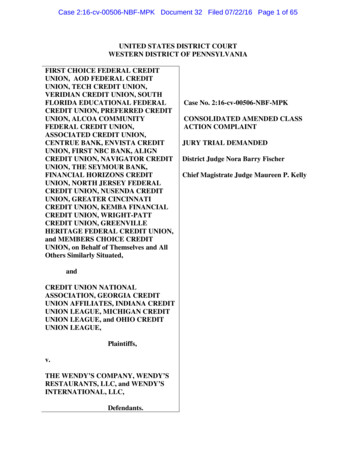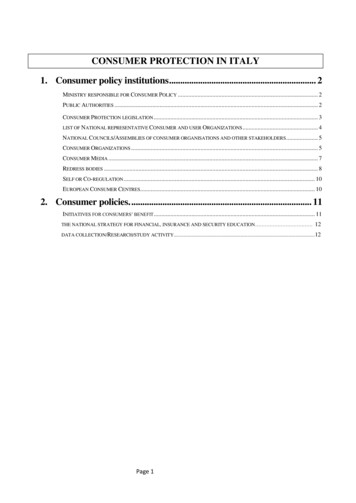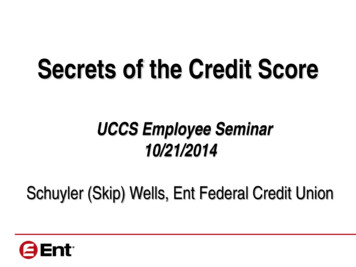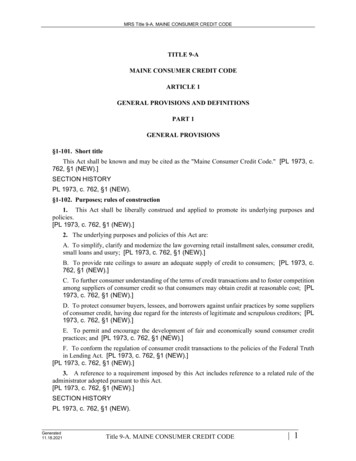
Transcription
CHRISTOPHER BROWNFinancial engineering, consumer credit,and the stability of effective demandAbstract: This paper examines the macroeconomic implications of recent developments in financial engineering, with particular emphasis on the post-1987growth of markets for securities backed by credit card, installment, studentloan, and home equity receivables. Three linkages of financial engineering toeffective demand are identified: (1) funding effects, (2) liquidity preference orspeculative effects, and (3) balance sheet or Minsky effects. Data from the Surveyof Consumer Finances are used to investigate the importance of asset-backedsecurity–related funding and balance sheet (Minsky) effects in the United States.Evidence is shown that financial engineering has boosted borrowing powerat all income levels. The liberal use of expanded borrowing opportunities hasfueled the growth of consumption—especially since 1995. However, a secularlyrising share of U.S. households have entered the categories of “speculative”or “Ponzi” finance units—a factor that raises doubts about the sustainabilityof the current spending boom.Key words: asset-backed securities, consumer credit, financial instability.Financial engineering describes the process of converting hitherto illiquidmortgage and consumer receivables into marketable securities as well asthe development of primary and secondary markets for derivative assetsof these types. This paper endeavors to shed light on the macroeconomicimplications of recent (within the past two decades) achievements offinancial engineering. Among the issues that receive attention: Has thesecuritization of mortgage and consumer loans made credit more widelyavailable, and if so, to what effect? With the deepening of markets forsecurities backed by mortgage, automobile, credit card, home equity,The author is Professor of Economics, Arkansas State University. An earlier versionof this paper was presented at the Association for Institutional Thought meeting, April21, 2006, in Phoenix. The author is indebted to Eric Tymoigne, Randall Kesselring,and James Washam for helpful comments. Gerhard Fries provided technical assistancewith the use of Survey of Consumer Finances data. Support from a College of Business summer research award is gratefully acknowledged.Journal of Post Keynesian Economics / Spring 2007, Vol. 29, No. 3 427 2007 M.E. Sharpe, Inc.0160–3477 / 2007 9.50 0.00.DOI 10.2753/PKE0160-3477290304
428JOURNAL OF POST KEYNESIAN ECONOMICSor educational loans, is there a nascent threat of instability arising fromspeculation? Finally, is financial engineering (partly) to blame for thedeteriorating status of a large number of household balance sheets in theUnited States in the past 10 to 15 years?What is financial engineering?Financial engineering is homologous with the process of securitization—that is, the reconfiguration of illiquid claims to future cash flows intostandardized, marketable assets. The term also applies to the creation ofsynthetic, derivative instruments that enable institutions (pension fundsor university endowments, for example) to hedge positions in securitiesbacked by conventional mortgage or consumer loans. This paper takesaim at two comparatively recent innovations—the mortgage-backedsecurity or MBS (tradable instruments collateralized mortgage loanobligations) and the asset-backed security or ABS (collateralized byconsumer debt).The asset securitization technique can be briefly described as follows:A finance company specializes in the sale of hire-purchase agreements(installment loans to finance cars, motorcycles, boats, or other items).Finance companies historically financed positions taken in consumerreceivables through bank loans or the direct issue of commercial paper.Under the new regime, consumer receivables are sold to a special purposevehicle (SPV)—that is, a company created for the express purpose ofstructuring these pools of future cash flows into homogenous lots thatcan be placed with large pension funds, insurance companies, and otherinstitutional portfolios. A trust agreement is created at the point of issuedthat requires the transfer of hire-purchase agreements (or credit card orstudent loans receivables, as the case may be) to a trust not controlled bythe loan originator (the finance company) or the SPV. The newly issuedsecurities are “backed” by the assets of the trust—hence, the term asset-backed securities. The pool of assets in the trust have been screenedby the originator, a rating agency, and in some cases, by an independentguarantor. The new notes issued by the SPV therefore carry an investment grade, making them substitutable with short-dated Treasury issuesor commercial paper.1 The mechanics of placement for ABSs are much1 Schwartz explains that “[a] securitization transaction can provide obvious costsavings by permitting an originator whose debt securities are rated less than investment grade . . . to obtain funding through an SPV where debt securities have an investment grade” (1994, p. 137).
FINANCIAL ENGINEERING, CONSUMER CREDIT, AND EFFECTIVE DEMAND429the same as for corporate equities or municipal bonds. A prospectusmust be circulated. Investment banks take the securities to market (and,as might be expected, competition for the lucrative fees that can be realized through ABS placement is fierce). The issuers of ABSs include allmajor players in the domestic consumer finance industry. A partial listing includes Wachovia Bank, Honda Finance, Nissan Motor AcceptanceCorporation, Toyota Motor Credit, Mitsubishi Finance, the Credit Store,Chase Manhattan Bank, Circuit City, Nieman Marcus, Dillards, J.C. Penney, Sears, Dayton-Hudson, Federated Department Stores, Banc One,Capital One, Citicorp, Ford Motor Credit Corporation, General MotorsAcceptance Corporation, and Bank of America. Giddy notes that[t]he asset securitization process, while complex, has won a secure placein corporate financing and investment portfolios because it can, paradoxically, offer originators a cheaper source of financing and investorsa superior return. Not only does securitization transform illiquid assetsinto tradable securities, but it also manages to transform risk by means ofthe separation of sound financial instruments from a company with littleor no loss. (2005)The ABS market has been buttressed by strong demand in the past several years as new issues have regularly been oversubscribed. In additionto their liquidity and attractive return, these securities appeal to banks,insurance companies, pension funds, and other institutions because therisks of holding them can be hedged with the use of other structuredfinancial products—that is, derivatives.Structured finance specialists identify two types of risk attached toABSs (or MBSs)—interest rate risk and default risk. Prepayment risk isa special category of interest rate risk and is mainly confined to the MBSsegment. Because mortgage debt instruments typically give borrowersthe option to pay off their notes at any time, MBSs have “embeddedcall options” (Lee, 2003, p. A14). Profit margins of leveraged MBSholders (particularly those with substantial long-term debt) are interestsensitive because a decline in rates will cause a surge in prepaymentsas homeowners refinance on more favorable terms. The more generalform of interest rate risk arises from a mismatch between maturitiesof liabilities and assets. The default risk affixed to specific categoriesof ABSs or MBSs is, owing to explicit or implicit federal governmentguarantees, virtually nil. For example, most of the assets that collateralizestudent loan asset-backed securities (SLABS) are federally guaranteedpursuant to the Higher Education Act of 1965. The status of securitiesbacked by mortgages is a little murkier. The dominant issuers, Freddie
430JOURNAL OF POST KEYNESIAN ECONOMICSMac and Fannie Mae, are now privately owned entities. However, hardlyanyone believes the federal government would stand by idly in the eventof a systemic default by mortgagees in trust pools underlying FederalNational Mortgage Association (FNMA) or General National MortgageAssociation (GNMA) issues.Derivatives enable institutions to insure against the loss of (financial)capital by shifting risk to other parties. For example, an institution seeking to hedge positions in stocks, commodities, currencies, or other assetsmay purchase an option to sell a market basket of stocks, commodities,and so on, at a specified price at a specified future date. The value ofthe option is ostensibly “derived” from the value of the underlying assets. The explosive growth of the derivatives trading since the 1980sis usually explained by two factors: (1) the growing concentration offinancial assets in professionally managed portfolios; and (2) developments in theory of finance—most importantly the Black–Scholes modelof options pricing.2The most widely used device is the over-the-counter credit defaultswap.3 This is an arrangement whereby the hedging party makes periodic“coupon” payments to a counterparty that is obligated to make a paymentto the first party in the event of a “credit event” (for example, default or adowngrade by rating agencies), the size of the payment being dependenton the market value of the “reference assets” following the credit event.4Total return swaps, or agreements between two parties to exchange thetotal returns from financial assets, is another means by which agents mayinsure against prepayment, interest rate, or default risk. 5Structural change in the lending industryThe financial innovations explicated above have brought forth a structural transformation of the mortgage and consumer lending industries.Table 1 reveals, for example, that whereas in 1976 traditional mortgage2See Black and Scholes (1973). For a discussion of the importance of the Black–Scholes theorem in the development of the securities industry, see Rubinstein (1987).3 For an explanation of different categories of derivatives, see Choudhry (2004).4 Hedge funds were counterparties to derivatives contracts insuring positions in GMand Ford Motor debt and suffered massive losses after downgrades by the rating agencies in May 2005. See Whitehouse (2005).5 Prepayment derivatives were invented in 2003. See Fabozzi (2005) for a description. Freddie Mac (which has immense holding of “retained” MBSs—valued at approximately 1.5 trillion, or about a quarter of the total outstanding, in 2005) is thesingle largest user of prepayment derivatives.
1976Percent oftotalAmount(millions ofdollars)1990YearAll holders889,202100.03,856,205Commercial banks151,32617.0843,136Savings institutions404,64445.5801,628Life insurance companies91,55510.3267,335Federal and related agencies66,7537.5250,762Mortgage pools or trusts49,8015.61,103,950Individuals and others125,12314.1638,172Source: Federal Reserve Bulletin, table B-72 ype of holderAmount(millions ofdollars)Table 1Mortgage debt outstanding by holder100.021.920.86.96.528.616.5Percent ,037,544996,468Amount(millions ofdollars)2004100.024.710.12.65.247.99.5Percent oftotalFINANCIAL ENGINEERING, CONSUMER CREDIT, AND EFFECTIVE DEMAND431
432JOURNAL OF POST KEYNESIAN ECONOMICSlenders (commercial banks and savings and loans) held a combined 62.5percent of mortgage debt outstanding on their books, by 2004 their sharehad fallen to 34.8 percent. The striking fact is the sharp increase in theproportion of mortgage debt held by “mortgage pools or trusts.”Figures 1 and 2 illustrate the growth of securities outstanding collateralized by credit card (revolving) and consumer installment (nonrevolving)receivables. Securities of this type have increased 20-fold since 1989.Forty-two percent of the growth of consumer credit outstanding between1989 and 2005 is accounted for by the growth of ABSs. Sixty-two percentof the growth of revolving credit outstanding since 1989 is accounted forby securities backed by nonrevolving (installment) receivables.The Bond Market Association reported that in September 2005 thevalue of ABSs outstanding was 1.92 trillion. The breakdown by loancategory was as follows: 513 billion (or 26.7 percent of the total) ofoutstanding ABSs were collateralized by home equity loans; 360.8 billion (18.8 percent) by credit card receivables; 226 billion (11.8 percent)by auto loans; 139 billion (7.2 percent) by student loans, and 683.8billion (35.5 percent) by “other.”6 Bonds backed by mortgage and consumer receivables together accounted for 32 percent of the bond marketin 2004, compared to 27 percent for U.S. government and agency debtand 20 percent for corporate debt.7When mortgage or consumer receivables are illiquid, the general availability or “supply” of credit (or finance) is limited by the tolerance ofwealth holders (or controllers) for illiquidity. The securitization of consumer receivables removes the constraint on the expansion of mortgageor consumer lending imposed by the general distaste of wealth controllersfor nontradable assets. By morphing into securities, consumer debts gainentrance to a vast new market which at present is (approximately) coextensive with the aggregate of professionally managed pools of financialassets worldwide.8 Assuming ABSs accounted for an unchanging fractionof holdings for these units, growth of institutional portfolios would bring6“Other” includes loans for manufactured housing and equipment leases.These figures were supplied by the Bond Market Association and were reported byLuchetti (2004).8 Giddy writes that “securitisation issues are still difficult for retail investors tounderstand. Hence most securitisations have been privately placed with professionalinvestors. However, it is likely that in [time] to come, retail investors could be attracted to securitised products” (http:absresearch.com, July 1, 2005).7
FINANCIAL ENGINEERING, CONSUMER CREDIT, AND EFFECTIVE DEMANDFigure 1 Asset-backed securities outstanding from U.S. issuers800Billions of 4NonrevolvingSource: Federal Reserve Board (www.federalreserve.gov/releases).Figure 2 Asset-backed securities as a percent of total consumer creditoutstanding in the United States353025201510509092949698Year0002Source: Federal Reserve Board (www.federalreserve.gov/releases).04433
434JOURNAL OF POST KEYNESIAN ECONOMICSFigure 3 Institutional portfolio assets in the United States (in trillions ofdollars)Source: OECD Institutional Investor Statistics 2003 (http://puck.sourceoecd.org).forth a shifting demand for these instruments, ceteris paribus. The prodigious growth of financial asset pools under professional managementis a striking development of the past quarter century. Financial assets of“institutional investors” in Organisation for Economic Cooperation andDevelopment (OECD) countries nearly doubled in money terms between1993 and 2001 (see Figure 3). The market value of assets held in U.S.institutional portfolios increased by a staggering 102 trillion in thesame period, or 112 percent (see Figure 4). It should also be pointed outthat the size of institutional portfolios has increased in relative as wellas absolute terms. That is, the proportion of total intangible assets underprofessional management has increased markedly. Institutions accountfor the lion’s share of daily volume on bourses worldwide.Although a thoroughgoing treatment of the causes of institutional portfolio growth is not indicated here, a few key factors can be identified.9 Demographics are clearly important. The United States, Europe, and Japanhave recently seen bulging huddles of postwar cohorts advance through9See Brown (1998).
436JOURNAL OF POST KEYNESIAN ECONOMICSeducations, and other items.10 The negative or destabilizing aspects ofthe new regime are of two types: (1) speculative or liquidity preferenceeffects, and (2) balance sheet or Minsky effects. The former effect maycause a constriction of the availability of funding, whereas the latter iscapable of impinging on the supply or demand for funding.The nexus of financial engineering (or securitization) to effectivedemand should be understood in relation to a basic principle of PostKeynesian thought: Navigating in a social environment that is uncertainor nonergodic—that is, that “outcomes on any specific future date [cannot] be reliably predicted by a statistical analysis of past and currentmarket data” (Davidson, 2002, p. 51)—gives rise to the desire for storesof value that are liquid. In a nonergodic, transmutable reality, the futureis not merely unknown—it is unknowable.11 Liquidity offers a means ofdeferring economic decision making, of “[evading] the consequences ofsuch unknowledge” (Shackle, 1989, p. 49).The fact that income is received in money—that is, in a form thatgives agents the power to withhold spending power from real sectorcirculation—would seem to present a crippling blow to the claim thatmodern economies exhibit a natural tendency to full employment. Theproduction of liquid assets, in contrast to tangible but illiquid capitalgoods, requires a minimal employment of real resources. This factor explains why liquidity preference is capable of causing an insufficiency ofeffective demand. The low elasticity of substitution between indivisible,specialized capital goods and money or marketable securities means thatthe accumulation of liquid claims to goods (saving) does not automati-10 Post Keynesians distinguish between finance and funding. Finance refers tocomparatively short-term loans to production units (for example, farmers, buildingcontractors, or small business) needed to bridge the interval between the disbursement of factor cost and receipt of income from the sale of crops, new homes, or othergoods and services. Finance is mainly provided by depository institutions. Funding isusually defined as demand for liquidity to purchase long-lived, tangible assets, and isaccomplished through the issue of new securities. As will be discussed later, a significant component of the spending power created by the issue of ABSs is used for thepurchase of nondurable items such as airline tickets or hotel lodging.11 Reality is transmutable when “future economic outcomes may be permanentlychanged in nature and substance by today’s actions of individuals or groups (for example, unions, cartels, or governments), often in ways not perceived by the creators ofchange” (Davidson, 2002, p. 52).
FINANCIAL ENGINEERING, CONSUMER CREDIT, AND EFFECTIVE DEMAND437cally result in the employment of economic resources to manufacturetangible stores of value.12The preference for liquid portfolio assets presents a formidable obstacleto capital development. The main contribution of financial engineeringlay in transforming owners’ or creditors’ legal claims to future incomestreams of business enterprises (the balance sheets of which, after all,consist mainly of specialized capital goods) into financial assets salable atlow transactions cost in orderly secondary markets. Securitization makescommitments to produce capital goods that are, from the collective pointof view, irrevocable nevertheless reversible for individuals. Securitizationand public ownership are innovations that relieve the tension betweenliquidity preference and the staggering capital requirements imposed bymodern production methods.13The existence of orderly, continuous spot markets for previously issuedequities and bonds is a necessary condition for a high volume of newissues, the proceeds of which supply the funding for investment. Doesit follow that financial engineering exerts an unambiguously beneficialeffect on effective demand? Keynes noted that[i]n the absence of security markets, there is no object in frequently attempting to revalue an investment to which we are committed. But theStock Exchange revalues many investments every day and the revaluationsgive a frequent opportunity to the individual (though not to the communityas a whole) to revise his commitments. . . . But the daily revaluations ofthe Stock Exchange, though they are primarily made to facilitate transfersof old investments between one individual and another, exert a decisiveinfluence on the rate of investment. (1936, p. 151)Price movements of existing securities are causally linked to the paceof new issues (and, hence, investment) because (1) there is near-perfectsubstitutability between old and new issues; and (2) (in mature economies,at least) the flow of new issues (say, per month) is miniscule in relationto the existing stock of shares or bonds. Soaring valuations improve the12 Davidson writes that “[t]he basic message of Keynes’s General Theory is that toogreat a demand for liquidity can prevent ‘saved’ (that is, unutilized or involuntarilyunemployed) real resources from being employed to expand the economy’s productivefacilities” (Davidson, 2002, p. 10).13 The progress of secondary markets for equities and bonds requires a reliable legalinfrastructure to enforce fiduciary standards, transparency, and debt covenants. Theinstitutional prerequisites for viable securities industries appear to have been underestimated by U.S. economic advisers to the Russian government, for example.
438JOURNAL OF POST KEYNESIAN ECONOMICSterms on which new issues can be floated off, whereas falling pricesheighten the risk that new offerings will be undersubscribed.14 Thus,speculation (or changing liquidity preference) is capable of perturbingthe scale of output and employment by virtue of the concatenation ofconditions in primary markets to prices prevailing in secondary marketsfor securities.15 It is by this mechanism that “bullishness” or “bearishness” impinges on the real economy. Keynes wrote that “[t]he questionof the desirability of having a highly organized market for dealing withdebts [or equities] presents us with a dilemma” (ibid., p. 172). On onehand, the financial engineering paved the way for the rise to dominanceof large-scale business organizations; but it left society more vulnerableto shocks emanating from the financial sector. However, the conventionalKeynesian view holds that changing liquidity preference (connected tothe speculative motive) mainly affects business investment. Taking intoaccount the structural changes in the mortgage and consumer lendingindustries described in the preceding section, have new channels openedup whereby changing views about an uncertain future condition decisionsto employ resources today? That is, has the emergence of secondarymarkets for MBS and ABS created the opportunity for speculation toshock housing and consumer goods markets?Balance sheet or “Minsky” effectsHyman Minsky (see Minsky, 1986) claimed that a key determinant ofinvestment (and, hence, the demand for funding) is the relationshipbetween the firms’ current flow of receipts from operations and their“liability structures”—that is, contractual obligations to pay interestand principal on existing debt. Minky’s cash flow–debt principle can beextended to consumption if (1) households carry substantial debts, and(2) a nontrivial share of household purchases are funded by the issue ofIOUs. Under these conditions, the growth of consumption expendituredepends partly on the willingness of households to layer balance sheets14 The sharp decrease in initial public offering (IPO) volume following the dot-comcrash provides an excellent recent example.15 The term rising liquidity preference connotes a general increase in the desire forassets that provide insurance against what Robinson called “capital uncertainty” orpotential loss of (financial) capital due to interest rate or share price fluctuations (seeRobinson, 1979, p. 138). Rising liquidity preference describes a “flight to safety” or ashift into asset groups characterized by low capital uncertainty. Included among theseis money proper but also near-monies such as commercial paper and short-dated, giltedged securities. For a reexamination of liquidity preference, see Brown (2004).
FINANCIAL ENGINEERING, CONSUMER CREDIT, AND EFFECTIVE DEMAND439with additional debt obligations and partly on the readiness of consumerlending agencies to accommodate credit demand. The willingness to borrow or lend is, in turn, conditioned by the sufficiency (or lack thereof)of current income with respect to debt service.Minsky developed the following taxonomy for borrowing units:1. Hedge units: Cash receipts (or income) are sufficient to repayinterest and principal.2. Speculative units: Cash receipts (or income) are adequate to repay interest but not principal. These units must roll over existingdebts.3. Ponzi units: Cash receipts (or income) are insufficient to repayinterest or principal. Ponzi units must add debts (or sell assets)merely to pay interest on existing debt obligations.The “financial instability” hypothesis posits a tendency to decay ofoverall balance sheet quality in the course of business cycle expansions.A boom underpinned by debt must inevitably result in the migration ofmany spending units from “hedge” to “speculative” and “Ponzi” status.Widespread financial deterioration may precipitate an episode of whatMinsky termed debt deflation. Debt deflation is potentially catastrophicbecause (1) it chokes off new borrowing to finance spending for tangible,reproducible things (such as producer and consumer durables); and (2) itentails a massive redirection of income flows from product markets todebt servicing. The severity of economic contractions is intensified as aconsequence of this process of balance sheet adjustment.The following is the main question of interest here: Has financial engineering increased the risk of debt deflation by easing the borrowingconstraint faced by the household sector? Applying the Minskian logicto the household sector, we may hypothesize that the likelihood of debtdeflation is directly proportional to the fraction of households that at aparticular point in time can be classified as speculative or Ponzi units.Thus, financial engineering may be said to be harmful if its effect is todiminish the share of consumers that practice hedge finance—an issuetaken up in the following section.Funding effects and consumptionA primary effect of the securitization of mortgage and consumerreceivables is to boost the borrowing power of households situatedacross a wide band of the income scale. Cross-sectional data reveal thatspending–income ratios tend to be higher for lower-income households
440JOURNAL OF POST KEYNESIAN ECONOMICSand vice versa—that is, the marginal propensity to consume out of themarginal increment of income is (on average) diminishing. Thus, widenedcredit availability has an effect comparable to that of reduced incomeinequality—that is, it makes the aggregate propensity to consume higherthan it would be otherwise.16If the thesis articulated above is correct, the consumption functionsshould exhibit structural instability—that is, regression coefficients forthe pre-ABS era should be different than those for the post-ABS era. Toexamine this question, an ordinary least squares estimation of a standard consumption model was performed using monthly U.S. data for1972–2005. The model posits consumption (C) as a function of personaldisposable income (DY), wealth as estimated by the opening monthlyvalue of the Standard and Poor’s Index of 500 stocks (SP), and interestrates as measured by the average rate of interest charged on loans issuedby automobile finance companies (r). C and DY are measured in billionsof dollars at seasonally adjusted, annual rates. The data were partitionedinto two subsamples—one set for the pre-ABS era (January 1972 toDecember 1987) and another for post-1988 (see estimates in Table 2). Intechnical terms, the structural relationships between time series variablesare stable if the subsets of coefficients are equal. The estimates reportedabove show substantial differences. Results of a Chow “breakpoint” testare displayed in Table 3 (see Chow, 1960). The F-statistic is used to testthe null hypothesis that both samples belong to the same regression—thatis, the coefficients are not time varying. The hypothesis of structuralstability can be rejected at the 0.001 level.The presence of structural instability is not by itself sufficient toestablish the importance of ABS-related funding effects. The case forfunding effects would be strengthened if it could be shown that (post1987) (1) many households have experienced an increase in their abilityto obtain credit for reasons unrelated to their creditworthiness; and (2) asufficient number of households have availed themselves of expandedoptions to borrow such that the growth of aggregate consumption hascome to be increasingly credit driven. With respect to (1) above, an indi-16This argument is developed at length in Brown (2004). With respect to the connection between distribution and the propensity to consume, Keynes stated that“[s]ince I regard the propensity to consume as being (normally) as such to have awider gap between income and consumption as income increases, it naturally followsthat the collective propensity for the community as a whole may depend . . . on thedistribution of incomes within it” (Keynes, 1939, p. 129).
FINANCIAL ENGINEERING, CONSUMER CREDIT, AND EFFECTIVE DEMAND441Table 2Least squares estimates of consumption specifications using monthlyU.S. dataSample1972–1987(n 193)1987–2005(n r–5.3724(–3.990)Adjusted R 20.999t-statistics are shown in able 3Chow breakpoint test (breakpoint is December 1987)F-statisticLog likelihood .000000vidual may find his or her borrowing power augmented as a result of anincrease in his or her income, length of employment, or a change in otherfactors weighed in credit scoring algorithms. The term expanded creditavailability de
ney, Sears, Dayton-Hudson, Federated Department Stores, Banc One, Capital One, Citicorp, Ford Motor Credit Corporation, General Motors Acceptance Corporation, and Bank of America. Giddy notes that [t]he asset securitization process, while complex, has won a secure place in corporate financing and investment portfolios because it can, para-

